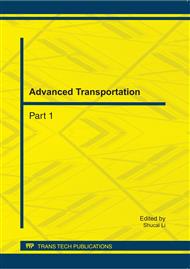p.903
p.907
p.911
p.919
p.925
p.931
p.935
p.942
p.947
The Impact of Traffic Information on Drivers’ Day-to-Day Route Choice Behavior
Abstract:
The influence of different traffic information on drivers’ day-to-day route choice behavior based on microscopic simulation is investigated. Firstly, it is assumed that drivers select routes in terms of drivers’ perceived travel time on routes. Consequently, the route choice model is developed. Then, updating the drivers’ perceived travel time on routes is modeled in three kinds of traffic information conditions respectively, which no information, releasing historical information and releasing predictive information. Finally, by setting a simple road network with two parallel paths, the drivers’ day-to-day route choice is simulated. The statistical characteristics of drivers’ behavior are computed. Considering user equilibrium as a yardstick, the effects of three kinds of traffic information are compared. The results show that the impacts of traffic information on drivers are related to the random level of driver’s route choice and reliance on the information. In addition, the road network cannot reach user equilibrium in three kinds of information. This research results can provide a useful reference for the application of traffic information system.
Info:
Periodical:
Pages:
925-930
Citation:
Online since:
September 2011
Authors:
Price:
Сopyright:
© 2011 Trans Tech Publications Ltd. All Rights Reserved
Share:
Citation:


